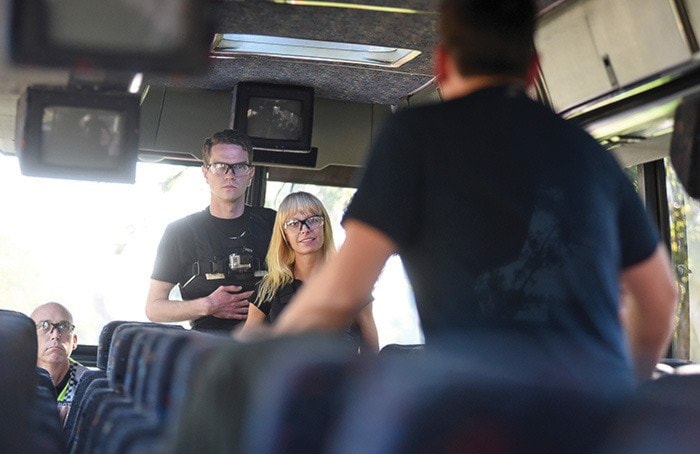— Pamela Roth
With my eyes closed, I’m guided into a room by Victoria police Const. Kristin Greffard and told to lie down on the floor.
She puts baby oil on my hands that’s meant to simulate blood. On this day I’m Constable Roth and I’ve been cut during a knife fight with a criminal.
“When I ask you to turn around, open your eyes and address the threat in front of you,” says Greffard.
Standing nearly on top of me is a large man armed with a butcher knife. I tell him to back away, but he doesn’t listen, only threatening to hurt me instead.
It’s a difficult situation. There’s no time to ponder what to do. My first response is to get up and run away, but I’m a police officer so I have to protect myself and the public from this dangerous man.
Instead of getting up, I freeze and smile at the man, hoping he’ll go away. Greffard calls a brief time out to remind me of the options I have available on my belt — a gun, pepper spray and baton.
Still on my back, I kick the man in the leg, then push myself across the floor, fumbling with my holster to retrieve my pistol.
It’s difficult to communicate with the man while trying to grab my gun. My heart is pounding. Eventually I shoot him in the leg and he falls to the ground.
“When we have somebody that’s coming at us with a knife, everybody is going to feel some degree of fear in that scenario and how they react to that and deal with it may be different from one person to the next,” said Greffard after the scenario.
“It all comes down to our threat perceptions, and if we choose a level of force we have to be able to articulate that lower levels of force were deemed ineffective or inappropriate, and high levels of force were justified.”
The scenario is one of five that members of the media went through as part of reality-based training for all members of the Victoria Police Department.
Using officers as actors trained to demonstrate certain behaviours, the scenarios are made as real as possible to enforce an officer’s fundamental skills and any deficiencies that may arise. Each scenario is based on real events that have happened in the department or other police agencies, along with trends officers are noticing such as more edged weapons on the street.
“We want to prepare officers so that in case they are presented with that, they’re not going to go into that fight or flight mode and fight because we don’t have the option of flight,” said Greffard.
“At the end of the day, I really like going home to my son, so I’m going to do everything I can in terms of training to prepare myself and the other officers to make sure they get home safely at the end of the night.”
In another scenario outside, I’m briefed about a situation that arose on a tourist bus. The bus was on its way from the Craigdorroch Castle to the Butchard Gardens when a passenger became erratic, causing the driver to pull over and evacuate the bus.
The driver tells me and my partner (Scott Cunningham from CTV News) more about the man I see pacing back and forth on the bus. He’s average size, in his early thirties, and talking fearfully about the demons he sees outside.
On the bus, we introduce ourselves as police officers that are here to help. Cunningham takes the lead and approaches the frightened man who’s out of his mind, trying to negotiate with him to come off the bus.
“What can we do to help you?” Cunningham asks calmly.
“It’s not safe! Get off the bus!” the man shouts, as he hops anxiously from seat to seat. I’m taken back by his strange demeanor, unsure of what to say or do.
The man pulls a knife when Cunningham gets too close. The situation is tense. Cunningham grabs his pistol and I take out pepper spray when Sgt. Greg Holmes calls a time out to remind us of the techniques used to communicate with someone in a crisis and establish a connection.
“You want to connect with that person. That’s what they need. They are having the worst day of their life,” said Holmes after the scenario.
“Communication is what solves an issue and having patience and taking time to do that. When you guys started talking and humanized yourself and built that trust and learned what was going on with him, it was easily resolved. He came off the bus and that’s the kind of outcome we want.”
